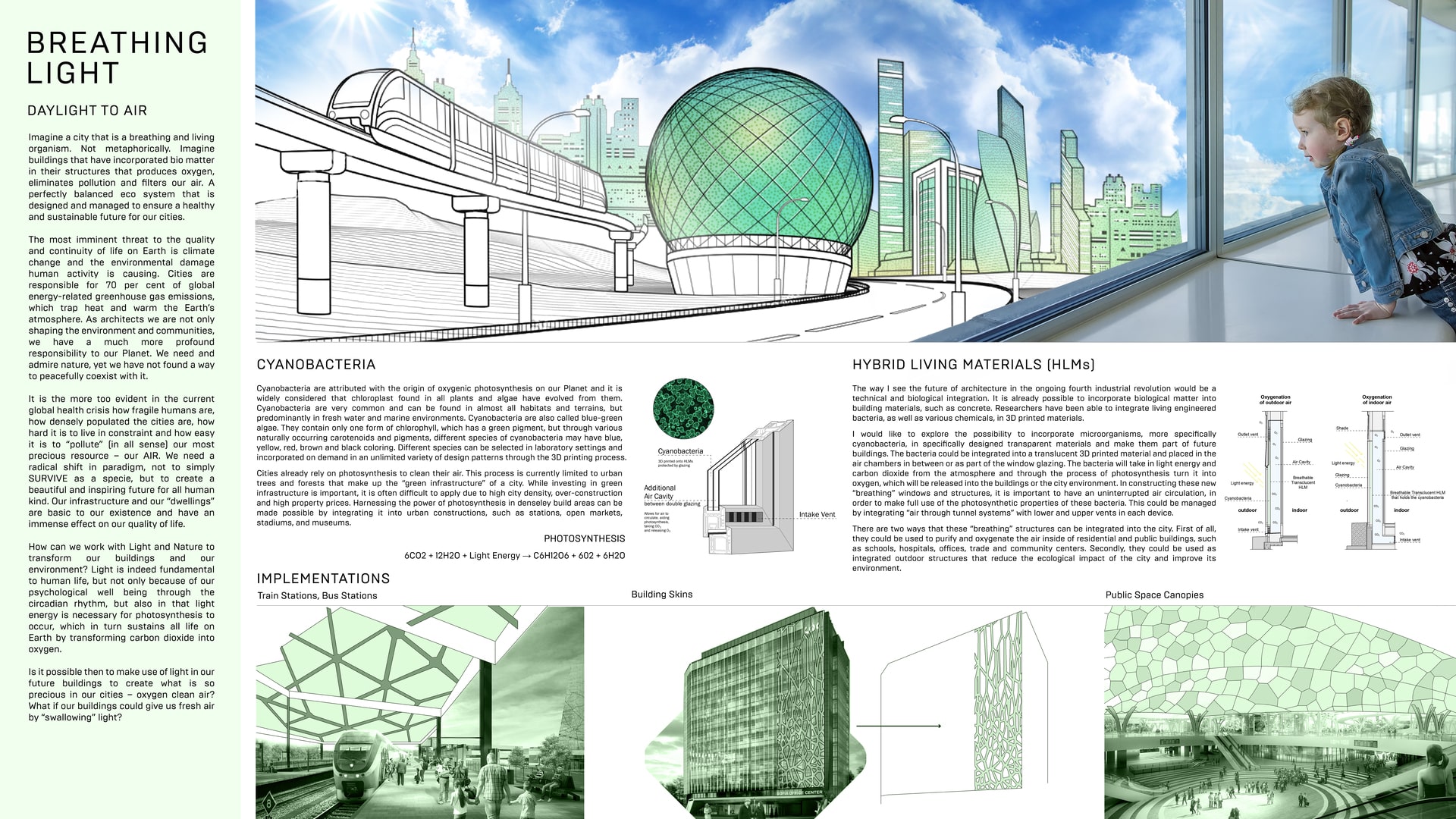Project Description
BREATHING LIGHT DAYLIGHT TO AIR Imagine a city that is a breathing and living organism. Not metaphorically. Imagine buildings that have incorporated bio matter in their structures that produces oxygen, eliminates pollution and filters our air. A perfectly balanced eco system that is designed and managed to ensure a healthy and sustainable future for our cities. The most imminent threat to the quality and continuity of life on Earth is climate change and the environmental damage human activity is causing. Cities are responsible for 70 per cent of global energy-related greenhouse gas emissions, which trap heat and warm the Earth’s atmosphere. As architects we are not only shaping the environment and communities, we have a much more profound responsibility to our Planet. We need and admire nature, yet we have not found a way to peacefully coexist with it. It is more too evident in the current global health crisis how fragile humans are, how densely populated the cities are, how hard it is to live in constraint and how easy it is to “pollute” (in all sense) our most precious resource – our AIR. We need a radical shift in paradigm, not to simply SURVIVE as a specie, but to create a beautiful and inspiring future for all humankind. Our infrastructure and our “dwellings” are basic to our existence and have an immense effect on our quality of life. How can we work with Light and Nature to transform our buildings and our environment? Light is indeed fundamental to human life, but not only because of our psychological wellbeing through the circadian rhythm, but also in that light energy is necessary for photosynthesis to occur, which in turn sustains all life on Earth by transforming carbon dioxide into oxygen. Is it then possible to make use of light in our future buildings to create what is so precious in our cities – oxygen and clean air? What if our buildings could give us fresh air by “swallowing” light? CYANOBACTERIA Cyanobacteria are attributed with the origin of oxygenic photosynthesis on our Planet and it is widely considered that chloroplast found in all plants and algae have evolved from them. Cyanobacteria are very common and can be found in almost all habitats and terrains, but predominantly in freshwater and marine environments. Cyanobacteria are also called blue-green algae. They contain only one form of chlorophyll, which has a green pigment, but through various naturally occurring carotenoids and pigments, different species of cyanobacteria may have blue, yellow, red, brown and black coloring. Different species can be selected in laboratory settings and incorporated on demand in an unlimited variety of design patterns through a 3D printing process. Cities already rely on photosynthesis to clean their air. This process is currently limited to urban trees and forests that make up the “green infrastructure” of a city. While investing in green infrastructure is important, it is often difficult to apply due to high city density, over-construction and high property prices. Harnessing the power of photosynthesis in densely built areas can be made possible by integrating it into urban constructions, such as stations, open markets, stadiums, and museums. Photosynthesis 6CO2 + 12H2O + Light Energy → C6H12O6 + 602 + 6H2O HYBRID LIVING MATERIALS (HLMs) The way I see the future of architecture in the ongoing fourth industrial revolution would be a technical and biological integration. It is already possible to incorporate biological matter into building materials, such as concrete. Researchers have been able to integrate living engineered bacteria, as well as various chemicals, in 3D printed materials. I would like to explore the possibility to incorporate microorganisms, more specifically cyanobacteria, in specifically designed transparent materials and make them part of future buildings. The bacteria could be integrated into a translucent 3D printed material and placed in the air chambers in between or as part of the window glazing. The bacteria will take in light energy and carbon dioxide from the atmosphere and through the process of photosynthesis turn it into oxygen, which will be released into the buildings or the city environment. In constructing these new “breathing” windows and structures, it is important to have an uninterrupted air circulation, in order to make full use of the photosynthetic properties of these bacteria. This could be managed by integrating “air through tunnel systems” with lower and upper vents in each device. There are two ways that these “breathing” structures can be integrated into the city. First of all, they could be used to purify and oxygenate the air inside of residential and public buildings, such as schools, hospitals, offices, trade and community centers. Secondly, they could be used as integrated outdoor structures that reduce the ecological impact of the city and improve its environment.
